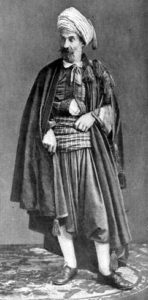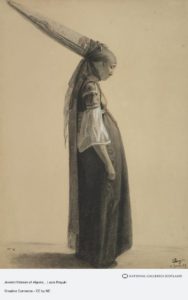The restrictions, which are intended to cover ‘significant’ objects under the Cultural Property Implementation Act include:
“G(3). Rope—Rope and string were used for a great variety of purposes, including binding, lifting water for irrigation, fishing nets, measuring, and stringing beads for jewelry and garments.”
Author Peter K. Tompa, writing in Cultural Property Observer, assesses the impact of a newly signed Memorandum of Understanding between the U.S. and the People’s Democratic Republic of Algeria.

Rope, Double beam weaving length 95 cm, Photo by Cangminzho, Creative Commons Attribution-Share Alike 4.0 International license.
The U.S. State Department has approved a MOU and import restrictions on behalf of Algeria’s authoritarian government. The restrictions were announced in a Federal Register notice on August 16, 2019.
Once again, the designated list is extremely broad. In what has to be a first, import restrictions have even been imposed on rope!
Both coin collectors and Jewish groups will once again be disappointed. Import restrictions have been applied on virtually all coins that were made or circulated within Algeria down to 1750, including those made outside the confines of what is now Algeria by the Carthaginians, Byzantines, Ottomans and Spanish. While there are no explicit restrictions on artifacts of Algeria’s displaced Jewish population, certain categories like “manuscripts” may nonetheless encompass Jewish religious artifacts like Torahs.

An Algerian Jewish man.
Import restrictions are controversial to the trade and collectors because, as construed by U.S. Customs and Border Protection, they embargo all undocumented items of types on designated lists imported after the effective date of the regulations, not just items illegally exported from a UNESCO State party after the effective date of import restrictions as required under CPIA, 19 U.S.C. §§ 2601, 2604, 2606, 2610. Such regulatory actions have converted CPIA import restrictions into embargoes of all objects of restricted types rather than targeted, prospective import restrictions that do not impact the purchase of artifacts from the legitimate marketplace abroad.
Import restrictions have been particularly hard on coin collectors and the small businesses of the numismatic trade because most collector’s coins (which typically are of limited value) lack detailed provenance histories necessary for legal import. This has greatly damaged the legitimate trade in such items with fellow collectors, especially from within the EU. Here, if anything, the problem will be exacerbated because Algeria was a French colony for such a long time. Many artifacts must have left Algeria for France during this period lawfully, but with little documentary proof. Often such material does not have a solid provenance, and cannot be legally imported under U.S. Custom and Border Protection procedures.

A Jewish woman of Algeria, by Louis Roguin, National Galleries of Scotland.
The restrictions on coins from the Federal Register announcement include:
Pre-Roman mints in Algeria include Cirta, Hippo Regius, Caesarea (Iol), Lix, Siga, and Timici. Roman provincial mints in Algeria include Caesarea, Cartenna, and Hippo Regius. Helpful reference books include: Corpus nummorum Numidiae Mauretaniaeque, 1955, J. Mazard, et al., Arts et metiers graphiques, Paris; Le Trésor de Guelma, 1963, R. Turcan, Arts et Métiers Graphiques, Paris; Etude sur la numismatique et l’histoire monétaire du Maroc: Corpus des dirhams idrissites et contemporains, 1971, D. Eustache, Banque du Maroc, Rabat; Corpus des Monnaies Alaouites, 1984, D. Eustache, Banque du Maroc, Rabat; The Roman Provincial Coinage, multiple volumes, 1992-, A. Burnett, et al., The British Museum Press, London. Some of the best-known types are described below:
- Greek—In silver, bronze, and gold, struck in Algeria and in nearby mints (Cyrene, Carthage).
- Roman Provincial—In bronze, struck at Roman and Roman provincial mints and found throughout Algeria.
- Numidian and Mauretanian—Associated with Numidian kings such as Micipsa, Jugurtha, Hiempsal II, and Juba I, and Mauretanian kings such as Syphax, Juba II, Ptolemy II of Mauretania, Bocchus I, and Bocchus II.
- Byzantine—In bronze, silver, and gold, struck in nearby mints like Carthage or mobile mints in Arab-Byzantine period Ifriqiya.
- Islamic—In silver and gold struck at various mints including Algiers, Bijaya, Biskra, Qusantina, and Tlemcen. Examples include any coins of the following dynasties: Almohad, Hafsid, Marinid, and Ziyanid.
- Ottoman—Ottoman coins of Algeria in silver, gold, billon, and copper, struck at various mints including Algiers, Qusantina, Tagdemt, and Tlemcen. Also Spanish coins of Oran in billon or copper, produced in Toledo or Madrid for use in Spanish Oran between 1618 and 1691.
The Department of State also issued a press release announcing the imminent signing of the MOU.
See also, We Don’t Need No Algerian Blockade; Against Jewish Protests, State Department Seeks to Add Another Brick in the Wall, Cultural Property News, July 12, 2018, noting that the only U.S. market for items of Algerian heritage is for items of Jewish heritage.
 The mosque of Abdallah ibn Salam, formerly the great Synagogue of Oran. Photo by DZ-Wahran User, Creative Commons Attribution-Share Alike 3.0 Unported license.
The mosque of Abdallah ibn Salam, formerly the great Synagogue of Oran. Photo by DZ-Wahran User, Creative Commons Attribution-Share Alike 3.0 Unported license. 

